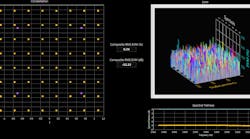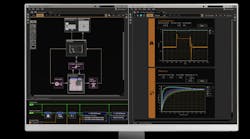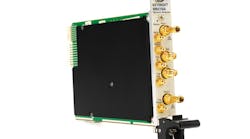Lab Validation Setup Aids in Characterizing RF Power Amplifiers
With frequencies for wireless communications moving higher—the 5G FR2 bands, for example—the characterization of RF power amplifiers (PAs) becomes more important than ever. If an RF power amplifier isn’t properly characterized, a host of system parameters are put at risk. Transmission quality, battery life, system reliability, and the error-vector magnitude (EVM) specs—the latter being so critical for complex modulation schemes—will all suffer, perhaps catastrophically, if the RF PA’s performance parameters are misunderstood.
Fortunately, test-and-measurement vendors like Emerson NI continuously facilitate the process of characterizing an RF PA. We recently had a chance to see a demonstration of the company’s lab validation setup for digital predistortion (DPD). It serves as a validation bench for any engineer needing to evaluate and characterize an RF PA.
In the demo (see the video), the device under test (DUT) is a high-power gallium-nitride (GaN) PA that’s connected to NI’s PXI vector signal transceiver (VST). NI’s VSTs combine an RF and baseband vector signal analyzer and generator with a user-programmable FPGA and high-speed serial and parallel digital interfaces for real-time signal processing and control from baseband to mmWave.
The VST generates the RF waveform that’s input to the DUT. After taking some RF power measurements, the RF signal out of the PA is reacquired by the VST. Meanwhile, digital DUT control and power are provided by NI’s source measure units (SMUs).
All of the hardware is tied together by what NI calls its RFIC Test Soft Front Panel, an interactive GUI from which users can configure the instruments, including the VST. They can also configure waveform settings, execute DUT control, and apply DPD. The latter is a key element in RF PA characterization.
Emerson NI offers a selection of DPD models from which to begin characterization. Elements such as the lookup table, memory polynomial, and generalized memory polynomial are all in one place so that users can quickly visualize, compare, and contrast the effects of various DPD algorithms. The end effect is to make it much easier to configure, measure, and then analyze those results.
Also covered in the demonstration video is Emerson NI’s PXI-5633 S-parameter add-on module, which pairs with its PXI-5842 vector signal transceiver to conduct S-parameter measurements alongside modulated RF measurements.
About the Author
David Maliniak
Executive Editor, Microwaves & RF
I am Executive Editor of Microwaves & RF, an all-digital publication that broadly covers all aspects of wireless communications. More particularly, we're keeping a close eye on technologies in the consumer-oriented 5G, 6G, IoT, M2M, and V2X markets, in which much of the wireless market's growth will occur in this decade and beyond. I work with a great team of editors to provide engineers, developers, and technical managers with interesting and useful articles and videos on a regular basis. Check out our free newsletters to see the latest content.
You can send press releases for new products for possible coverage on the website. I am also interested in receiving contributed articles for publishing on our website. Use our contributor's packet, in which you'll find an article template and lots more useful information on how to properly prepare content for us, and send to me along with a signed release form.
About me:
In his long career in the B2B electronics-industry media, David Maliniak has held editorial roles as both generalist and specialist. As Components Editor and, later, as Editor in Chief of EE Product News, David gained breadth of experience in covering the industry at large. In serving as EDA/Test and Measurement Technology Editor at Electronic Design, he developed deep insight into those complex areas of technology. Most recently, David worked in technical marketing communications at Teledyne LeCroy, leaving to rejoin the EOEM B2B publishing world in January 2020. David earned a B.A. in journalism at New York University.





